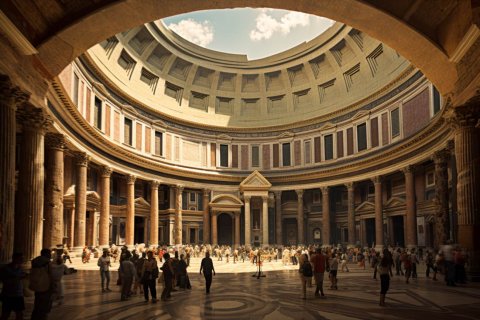Rome: Discover the Architectural Marvels of the Pantheon
Join a guided tour offering fast-track access to the Pantheon, an extraordinary architectural wonder of ancient Rome. Walk along the marble floor as your knowledgeable guide regales you with the monument's intriguing history.
Experience the awe-inspiring magnificence of this Roman relic and be transported back in time to the era of Agrippa. Delve into the secrets of the Pantheon's history, its engineering marvels, and the significant relocation of martyrs' remains ordered by Pope Boniface IV in 608.
Marvel at the colossal dome, boasting a remarkable diameter of 43 meters and the famed oculus allowing natural light to grace the interior. Discover the notable figures laid to rest within this ancient church as you skip the line for swift entry.
This guided tour offers a deep dive into the Pantheon's fascinating past, making it an essential part of your Rome itinerary.
What's Included: - Live guide
- Guided tour
- Headsets to ensure clear guide audio (for groups of over 8 people)
- Skip-the-line tickets
Meeting Point:
We gather in front of "Antica Salumeria," Piazza della Rotonda, 4, just opposite the Pantheon.
Important Reminders:
- Protect yourself from the sun with a sun hat.
- Wear comfortable shoes for exploring.
- Be prepared with rain gear for unexpected weather.
- Please refrain from bringing luggage or large bags.
Plan Your Visit:
This tour is available rain or shine, and all visitors should ensure proper attire covering shoulders and knees.
Price: Starting from $25.62 per person, save up to 16%.
Duration: Approximately 1 hour - 65 minutes
Reviews Summary:
Rated at 4.6/5 based on 289 reviews, this guided tour is highly recommended by travelers for its engaging guides and captivating narrative.
History and Significance of the Pantheon, Secrets of the Pantheon's Architecture
The Pantheon is a marvel of ancient Roman architecture and stands as a symbol of the architectural prowess of the Roman Empire. The word "Pantheon" is derived from the Greek words "pan," meaning all, and "theos," meaning gods. The structure was originally dedicated to all the gods of ancient Rome.
The Pantheon we see today in Rome was built during the reign of Emperor Hadrian, between 118 and 128 AD. However, the original Pantheon, commissioned by Marcus Agrippa during the reign of Augustus, was destroyed in a fire in 80 AD. Hadrian's version was a magnificent reconstruction of the original, showcasing his admiration for Roman architecture and engineering.
The architecture of the Pantheon is an engineering marvel. The most distinctive feature is the massive dome, which was the largest dome in the world for more than a millennium. The dome has a circular opening at the top, known as the oculus, which provides natural light to the interior.
The construction of the Pantheon's dome is a testament to the ingenuity of Roman architects and engineers. The dome's design distributes weight effectively, allowing it to remain stable and structurally sound. The use of concrete, with varying compositions and densities, contributed to the dome's strength and lightness.
The interior of the Pantheon is equally impressive. The vast space beneath the dome is a perfect sphere in both diameter and height. The oculus at the top allows sunlight to penetrate, creating a fascinating interplay of light and shadow within the space.
The Pantheon's historical significance goes beyond its architectural brilliance. It served as a place of worship for various deities and, over time, was consecrated as a Christian church dedicated to St. Mary and the Martyrs. This transformation allowed the Pantheon to survive centuries of neglect and potential destruction.
Today, the Pantheon stands as a popular tourist attraction, drawing visitors from around the world who come to marvel at its architectural grandeur and historical importance.
Frequently Asked Questions
1. When was the Pantheon built?
The Pantheon we see today in Rome was built between 118 and 128 AD during the reign of Emperor Hadrian. However, the original Pantheon, commissioned by Marcus Agrippa, was built around 27 BC to 14 AD and was later rebuilt by Hadrian.
2. What is the significance of the Pantheon?
The Pantheon was originally dedicated to all the gods of ancient Rome, symbolizing Roman religious beliefs. Over time, it was transformed into a Christian church, honoring St. Mary and the Martyrs. Its architectural brilliance also holds great significance, showcasing Roman engineering and design excellence.
3. How was the Pantheon's dome constructed?
The Pantheon's dome was constructed using concrete with varying compositions and densities, allowing for its immense size and stability. The dome's design distributed weight effectively, and the circular oculus at the top provides natural light and adds to its structural integrity.



